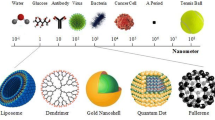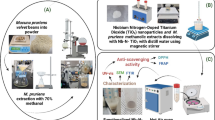Abstract
Titanium dioxide nanoparticles (TiO2NPs) are increasingly being used in various industrial applications including the production of paper, plastics, cosmetics and paints. With the increasing number of nano-related products, the concern of governments and the general public about the health and environmental risks, especially with regard to occupational and other environmental exposure, are gradually increasing. However, there is insufficient knowledge about the actual affects upon human health and the environment, as well as a lack of suitable biomarkers for assessing TiO2NP-induced cytotoxicity. Since the respiratory tract is likely to be the main exposure route of industrial workers to TiO2NPs, we investigated the cytotoxicity of the anatase and rutile crystalline forms of TiO2NPs in A549 cells, a human alveolar type II-like epithelial cell line. In addition, we evaluated the transcript and protein expression levels of two heat shock protein (HSP) members, Grp78 and Hsp70, to ascertain their suitability as biomarkers of TiO2NP-induced toxicity in the respiratory system. Ultrastructural observations confirmed the presence of TiO2NPs inside cells. In vitro exposure of A549 cells to the anatase or rutile forms of TiO2NPs led to cell death and induced intracellular ROS generation in a dose-dependent manner, as determined by the MTS and dichlorofluorescein (DCF) assays, respectively. In contrast, the transcript and protein expression levels of Hsp70 and Grp78 did not change within the same TiO2NPs dose range (25–500 μg/ml). Thus, whilst TiO2NPs can cause cytotoxicity in A549 cells, and thus potentially in respiratory cells, Hsp70 and Grp78 are not suitable biomarkers for evaluating the acute toxicological effects of TiO2NPs in the respiratory system.







Similar content being viewed by others
References
Kaida T, Kobayashi K, Adachi M, Suzaki F (2004) Optical characteristics of titanium oxide interference film and the film laminated with oxides and their applications for cosmetics. J Cosmet Sci 55:219–220
Allen NS, Edge M, Sandoval G, Verran J, Stratton J, Maltby J (2005) Photocatalytic coatings for environmental applications. Photochem Photobiol 81:279–290
Higarashi NM, Jardim WE (2002) Remediation of pesticide contaminated soil using TiO2 mediated by solar light. Catal Today 76:201–207
Konstantinou IK, Albanis TA (2004) TiO2-assisted photocatalytic degradation of azo dyes in aqueous solution: kinetic and mechanistic investigation-a review. Appl Catal B Environ 49:1–14
Oberdöster G, Maynard A, Donaldson K, Castranova V, Fitzpatrick J, Ausman K, Carter J, Karn B, Kreyling W, Lai D, Olin S, Monteiro-Riviere N, Warheit D, Yang H (2005) Principles for characterizing the potential human health effects from exposure to nanomaterials: elements of a screening strategy. Particle Fibre Toxicol 2:2–8
Oberdöster G, Oberdöster E, Oberdöster J (2005) Nanotoxicology: an emerging discipline evolving from studies of ultrafine particles. Environ Health Perspect 113:823–839
Simon-Deckers A, Gouget B, Mayne-L’Hermite M, Herlin-Boime N, Reynaud C, Carrière M (2008) In vitro investigation of oxide nanoparticle and carbon nanotube toxicity and intracellular accumulation in A549 human pneumocytes. Toxicology 253:137–146
Bhattacharya K, Davoren M, Boertz J, Schins RPF, Hoffmann E, Dopp E (2009) Titanium dioxide nanoparticles induce oxidative stress and DNA-adduct formation but not DNA-breakage in human lung cells. Particle Fibre Toxicol 6:1–11
Shi Y, Wang F, He J, Yadav S, Wang H (2010) Titanium dioxide nanoparticles cause apoptosis in BEAS-2B cells through the caspase 8/t-Bid-independent mitochondrial pathway. Toxicol Lett 196:21–27
Geiser M, Casaulta M, Kupferschmid B, Schulz H, Semmler-Behnke M, Kreyling W (2008) The role of macrophages in the clearance of inhaled ultrafine titanium dioxide particles. Am J Respir Cell Mol Biol 28:371–376
Golli-Bennour EE, Bacha H (2011) Hsp70 expression as biomarkers of oxidative stress: mycotoxin’s exploration. Toxicology 287:1–7
Hartl FU (1996) Molecular chaperones in cellular protein folding. Nature 381:571–579
Schlesinger MJ (1990) Heat shock proteins. J Biol Chem 265:12111–12114
Gupta SC, Sharma A, Mishra M, Mishra RK, Chowdhuri DK (2010) Heat shock proteins in toxicology: how close and how far? Life Sci 86:377–384
Lanneau D, Wettstein G, Bonniaud P, Garrido C (2010) Heat shock proteins: cell protection through protein triage. Sci World J 10:1543–1552
Vos MJ, Hageman J, Carra S, Kampinga HH (2008) Structural and functional diversities between members of human HSPB, HSPH, HSPA, and DNAJ chaperone families. Biochemistry 47:7001–7011
Ni M, Zhang Y, Lee AS (2011) Beyond the endoplasmic reticulum: atypical GRP78 in cell viability, signaling and therapeutic targeting. Biochem J 434:181–188
Lee AS (2007) GRP78 induction in cancer: therapeutic and prognostic implications. Cancer Res 67:3476–3499
Suzuki H, Toyooka T, Ibuki Y (2007) Simple and easy method to evaluate uptake potential of nanoparticles in mammalian cells using a flow cytometric light scatter analysis. Environ Sci Technol 41:3018–3024
Yoshida Y, Shimakawa S, Itoh N, Niki E (2007) Action of DCFH and BODIPY as a probe for radical oxidation in hydrophilic and lipophilic domain. Free Radic Res 37:861–72
Maniratanachote R, Miami K, Katoh M, Nakajima M, Yokoi T (2005) Chaperone proteins involved in troglitazone-induced toxicity in human hepatoma cell lines. Toxicol Sci 83:293–302
Lu TH, Su CC, Chen YW, Yang CY, Wu CC, Hung DZ, Chen CH, Cheng PW, Liu SH, Huang CF (2011) Arsenic induces pancreatic β-cell apoptosis via the oxidative stress-regulated mitochondria-dependent and endoplasmic reticulum stress-triggered signaling pathways. Toxicol Lett 201:15–26
Ahamed M, Posgai R, Gorey TJ, Nielsen M, Hussain SM, Rowe JJ (2010) Silver nanoparticles induced heat shock protein 70, oxidative stress and apoptosis in Drosophila melanogaster. Toxicol Appl Pharmacol 242:263–269
Liu F, Inageda K, Nishitai G, Matsuoka M (2006) Cadmium induces the expression of Grp78, an endoplasmic reticulum molecular chaperone, in LLC-PK1 renal epithelial cells. Environ Health Perspect 114:859–864
Forti F, Salovaara S, Cetin Y, Bulgheroni A, Tessadri R, Jennings P, Pfaller W, Prieto P (2011) In vitro evaluation of the toxicity induced by nickel. Toxicol In Vitro 25:454–461
Ahamed M, Siddiqui MA, Akhtar MJ, Ahmad I, Pant AB (2010) Genotoxic potential of copper oxide nanoparticles in human lung epithelial cells. Biochem Biophys Res Commun 396:578–583
Timblin CR, Janssen YMW, Goldberg JL, Mossman BT (1998) Grp78, Hsp72/72 and CJUN stress protein levels in lung epithelial cells exposed to asbestos, cadmium, or H2O2. Free Radical Biol Med 24:632–642
Rothen-Rutishauser B, Blank F, Mühlfeld C, Gehr P (2008) In vitro models of the human epithelial airway barrier to study the toxic potential of particulate matter. Expert Opin Drug Metab Toxicol 4:1075–1089
Thio BJR, Zhou D, Keller AA (2011) Influence of natural organic matter on the aggregation and deposition of titanium dioxide nanoparticles. J Hazard Mater 189:556–63
Allouni ZE, Cimpan MR, Hol PJ, Skodvin T, Gjerdet NP (2009) Agglomeration and sedimentation of TiO2 nanoparticles in cell culture medium. Colloids Surf B: Biointerf 68:83–87
Singh S, Shi T, Duffin AC, Berlo DV, Hohr D, Fubini B, Martra G, Fenoglio BPJA, Schins RPF (2007) Endocytosis, oxidative stress and IL-8 expression in human lung epithelial cells upon treatment with fine and ultrafine TiO2: role of the specific surface area and of surface methylation of the particles. Toxicol Appl Pharmacol 222:141–151
Srivastava RK, Rahman Q, Kashyap MP, Lohani M, Pant AB (2011) Ameliorative effects of dimetylthiourea and N-acetylcysteine on nanoparticles induced cyto-genotoxicity in human lung cancer cells-A549. PLoS One 6:1–12
Malhotra JD, Miao H, Zhang K, Wolfson A, Pennathur S, Pipe SW, Kaufman RJ (2008) Antioxidants reduce endoplasmic reticulum stress and improve protein secretion. Proc Natl Acad Sci U S A 105:18525–18530
Park EJ, Yi J, Chung KH, Ryu DY, Choi J, Park K (2008) Oxidative stress and apoptosis induced by titanium dioxide nanoparticles in cultured BEAS-2B cells. Toxicol Lett 180:222–2229
Hfaiedh N, Allagui AS, El Feki A, Gaubin Y, Murat JC, Soleilhavoup JP, Croute F (2005) Effects of nickel poisoning on expression pattern of the 72/73 and 94 kDa stress proteins in rat organs and in the COS-7, HepG2, and A549 cell lines. J Biochem Mol Toxicol 19:12–18
Croute F, Beau B, Arrabit C, Gaubin Y, Delmas F, Murat JC, Soleilhavoup JP (2000) Environ Health Perspect 108:55–60
NIOSH. Current intelligence bulletin 63: Occupational exposure to titanium dioxide. Department of Health and Human Services. Centers for Disease Control and Prevention. National Institute for Occupational Safety and Health. DHHS (NIOSH) Publication No. 2011–160
Sayes CM, Reed KL, Warheit DB (2007) Assessing toxicity of fine and nanoparticles: Comparing in vitro measurement to in vivo pulmonary toxicity profiles. Toxicol Sci 97:163–180
Acknowledgements
This work was financial supported by the Research, Development and Engineering Fund through the National Nanotechnology, NSTDA, Thailand. We thank Dr. Robert Butcher for comments and for the English language review.
Author information
Authors and Affiliations
Corresponding author
Electronic supplementary material
Below is the link to the electronic supplementary material.
ESM 1
(JPEG 62 kb)
Rights and permissions
About this article
Cite this article
Aueviriyavit, S., Phummiratch, D., Kulthong, K. et al. Titanium Dioxide Nanoparticles-Mediated In Vitro Cytotoxicity Does Not Induce Hsp70 and Grp78 Expression in Human Bronchial Epithelial A549 Cells. Biol Trace Elem Res 149, 123–132 (2012). https://doi.org/10.1007/s12011-012-9403-z
Received:
Accepted:
Published:
Issue Date:
DOI: https://doi.org/10.1007/s12011-012-9403-z




